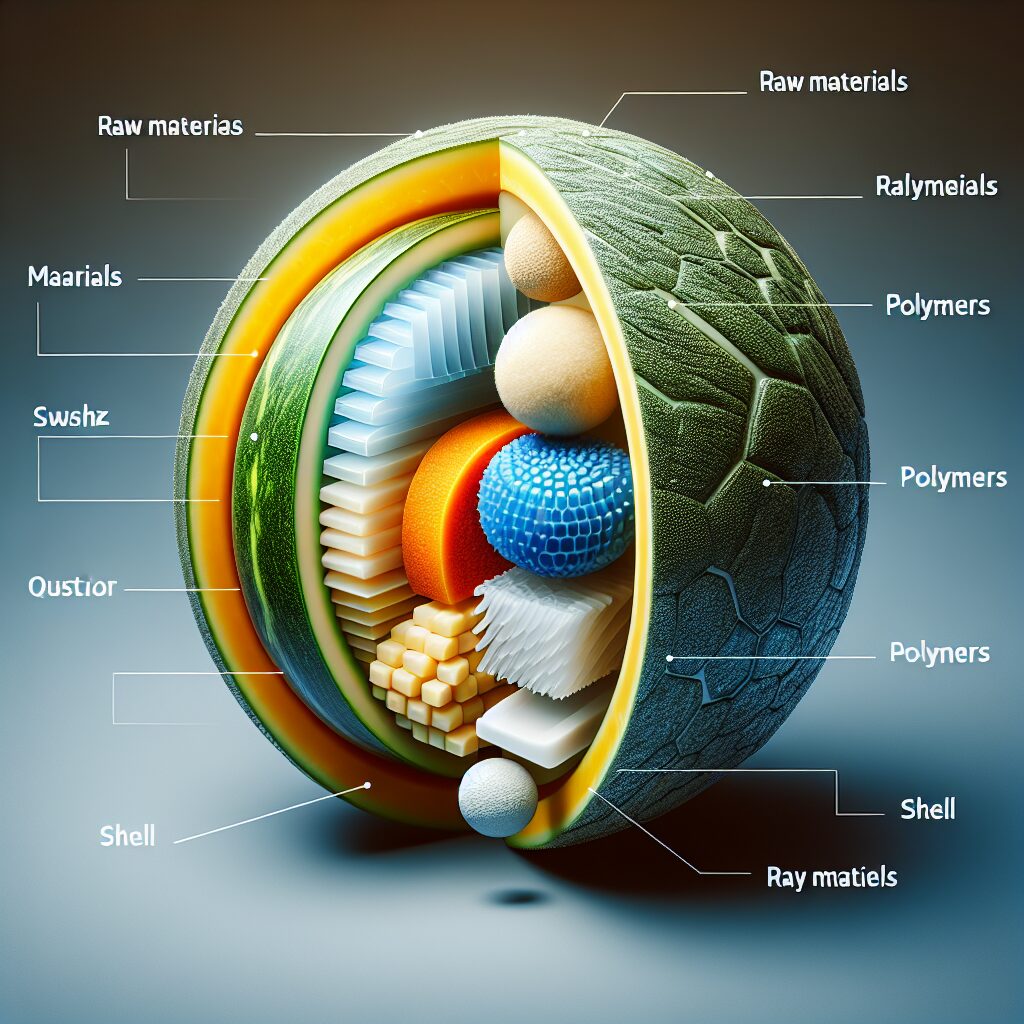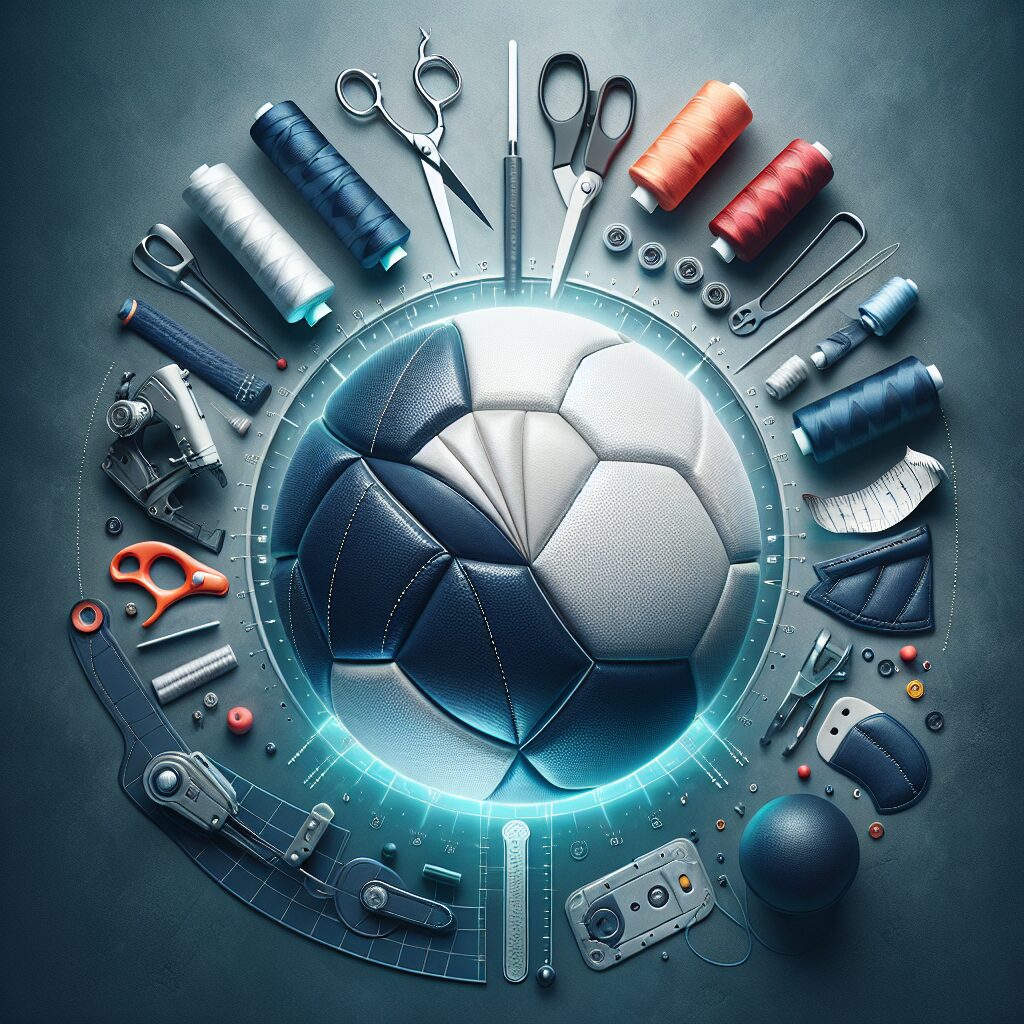Rugby, a popular contact sport known for its fast-paced action and fierce physicality, relies heavily on the performance of its key equipment – the rugby ball. The science behind rugby ball material choices plays an integral role in determining the ball’s characteristics and how it performs on the field. Did you know that rugby balls were originally made from pig’s bladder, back in the early days of the sport? This unique insight into rugby ball history illustrates the significant advancements in materials used in the modern game.
The choice of materials impacts various aspects of the rugby ball’s performance, including its flight, grip, durability, and overall feel. For instance, the shape and design of the ball, combined with the material used for its outer casing, greatly influence its aerodynamics. The surface texture, often achieved through specific material choices, can enhance players’ grip and handling, ensuring secure catches and accurate passes. Additionally, the durability of the ball is crucial, as it needs to withstand the physical demands of the game. These factors, among others, make the science behind rugby ball material choices a fascinating subject to explore.
In the upcoming sections, we will delve deeper into the key takeaways related to the science behind rugby ball material choices. We will examine the influence of various materials on the ball’s flight, grip, durability, and other factors essential to understanding the game’s dynamics. By gaining insights into the composition and characteristics of different rugby ball materials, players, coaches, and enthusiasts can make informed decisions when selecting the ideal ball for their game. Let us now dive into the fascinating world of rugby ball materials and discover the science that makes it all possible.
Key Takeaways
1. Material choices for rugby balls are crucial for performance, with a range of factors influencing the decision-making process.
2. The outer material of a rugby ball affects its grip, durability, and flight characteristics, influencing how players can handle and control the ball during a game.
3. Synthetic materials, such as polyurethane, offer benefits like water resistance and durability, making them a popular choice for all-weather play.
4. Natural materials like leather provide a traditional feel but require more maintenance and can be affected by weather conditions, impacting performance and longevity.
5. The core construction of rugby balls, often made of latex or rubber, plays a significant role in ball dynamics, affecting bounce, shape retention, and overall performance on the field.
What Are the SEO-optimized Material Choices Behind a Rugby Ball?
1. Material Composition:
The science behind rugby ball material choices begins with the composition of the ball. Rugby balls are typically made with four main materials: leather, synthetic leather, rubber, and foam. Each material offers unique characteristics that affect the ball’s performance and durability.
2. Leather:
Leather has long been the traditional choice for rugby balls. It offers exceptional grip, softness, and responsiveness. Furthermore, leather balls develop a natural grip over time as they absorb moisture from the players’ hands. However, leather balls require regular maintenance and may not be suitable for wet or muddy conditions.
3. Synthetic Leather:
Synthetic leather has gained popularity as an alternative to traditional leather. It provides similar grip and feel, but with added durability and resistance to moisture. These balls require less maintenance and can withstand a variety of weather conditions, making them ideal for both amateur and professional rugby matches.
4. Rubber:
Rubber rugby balls are commonly used for training and recreational purposes. They offer good durability, weather resistance, and affordability. Rubber balls are suitable for use on different playing surfaces and can withstand rough handling. However, they may lack the same level of grip and control as leather or synthetic leather options.
5. Foam:
Foam rugby balls are designed for beginners, especially young players. They offer enhanced safety and reduced impact during training sessions or games. Foam balls are softer and lighter, making them easier to handle and minimizing the risk of injuries. These balls are commonly used in schools or introductory rugby programs.
6. The Impact of Material Choices on Performance:
The choice of material directly affects the performance of a rugby ball. Factors such as grip, flight stability, and how the ball interacts with players’ hands and feet are influenced by the material composition. Understanding these effects can help players and teams make informed decisions when selecting the right rugby ball for their specific needs.
7. Considerations for Weather Conditions:
Weather conditions, particularly rain and humidity, greatly impact the performance of a rugby ball. Leather balls tend to become heavier and lose grip when wet, while synthetic leather balls maintain their properties better. Rubber balls offer reliable performance even in rainy conditions, making them suitable for wetter climates or water-based playing surfaces.
8. Maintaining Rugby Balls:
Regardless of the material chosen, proper care and maintenance are essential for prolonging the lifespan of rugby balls. Regular cleaning, drying, and conditioning can help preserve the grip and performance qualities. Leather balls may require additional conditioning to prevent drying out, while synthetic leather, rubber, and foam balls can be easily cleaned with mild soap and water.
9. Choosing the Right Ball for Specific Situations:
Depending on the level of play, stadium conditions, and personal preferences, players may need to select different rugby balls. Professional matches often require specific ball certifications and may have regulations regarding the use of certain materials. Similarly, training sessions, amateur games, and recreational play can benefit from different material choices based on the players’ skill levels and environmental factors.
Guides for Choosing the Right Rugby Ball Material:
1. What material should I choose for wet weather conditions?
In wet weather conditions, it is recommended to opt for synthetic leather or rubber balls due to their superior grip and resistance to moisture.
2. Which material is ideal for training sessions with beginners?
For training sessions involving beginners or young players, foam rugby balls are the ideal choice. They offer enhanced safety and reduced impact during practice.
3. Are there any regulations regarding ball materials in professional matches?
Yes, professional matches often have specific regulations regarding ball materials. It is essential to comply with these regulations and use balls that meet the required certifications.
4. How should I maintain and clean my rugby ball?
To ensure better longevity and performance, rugby balls should be regularly cleaned with mild soap and water. Leather balls may require additional conditioning or oiling to prevent drying out.
5. Can I use different balls for recreational play?
Recreational play allows for more flexible choices, and players can use different materials based on personal preferences and playing conditions. Rubber balls are often a popular choice for recreational play.
The Science Behind Rugby Ball Material Choices
FAQ:
What factors are considered when selecting materials for a rugby ball?
When selecting materials for a rugby ball, factors such as grip, durability, water resistance, and impact absorption are taken into consideration. The materials must provide a secure grip for players, withstand the rough handling during gameplay, be resistant to water absorption, and offer adequate shock absorption to reduce the risk of injury.
Are there different types of material options available for rugby balls?
Yes, there are various material options available for rugby balls. Common materials include genuine leather, synthetic leather, polyurethane, and rubber. Each material has its own unique characteristics, offering different levels of grip, durability, and performance.
Which material provides the best grip for a rugby ball?
The material that typically provides the best grip for rugby balls is genuine leather. Leather balls have natural properties that offer excellent grip, especially when they are broken-in properly. However, synthetic leather options have also been developed with advanced grip technology to provide comparable grip levels.
Do rubber rugby balls offer sufficient durability?
Yes, rubber rugby balls are known for their durability. They are specifically designed to withstand the rigors of intense gameplay and regular use. Rubber material offers great resistance to wear and tear, making it a popular choice for training balls and rough surfaces.
Are there any advantages to using synthetic leather rugby balls?
Yes, synthetic leather rugby balls offer several advantages. They are typically more cost-effective compared to genuine leather balls, making them accessible to a wider range of players. Synthetic leather is also more resistant to water absorption, allowing the ball to maintain its performance in wet conditions.
Which material provides the best water resistance for rugby balls?
Polyurethane is generally considered to provide the best water resistance for rugby balls. It is a synthetic material that helps prevent water absorption, allowing the ball to maintain its shape and performance even in wet playing conditions.
Do the material choices affect the flight and trajectory of the rugby ball?
Yes, the material choices can impact the flight and trajectory of the rugby ball. The weight, surface texture, and composition of the materials can influence how the ball moves through the air. It is important to select materials that offer good aerodynamic properties to achieve desired flight characteristics.
Can the choice of material affect player safety?
Yes, the choice of material can affect player safety. Materials that provide better shock absorption help reduce the impact forces transmitted to players upon contact. High-quality materials with good grip can also prevent the ball from slipping out of players’ hands, reducing the risk of mishaps during gameplay.
What should I consider when selecting a rugby ball for personal use?
When selecting a rugby ball for personal use, you should consider factors such as your skill level, playing conditions, and budget. If you are a beginner or playing on rough surfaces, a more durable material like rubber or synthetic leather may be suitable. Advanced players may prefer genuine leather balls for the best grip and performance.
Can the choice of material affect kicking accuracy?
Yes, the choice of material can affect kicking accuracy. The surface texture and grip of the material can influence how the ball interacts with the foot, affecting the accuracy and control of kicks. It is important to consider the materials that provide the desired level of grip for better kicking performance.
Final Thoughts:
The Importance of Material Selection for Rugby Balls
The science behind rugby ball material choices plays a crucial role in the overall performance and safety of the game. The right material selection ensures optimal grip, durability, water resistance, and impact absorption, providing players with a reliable tool to enhance their gameplay. Whether you’re a professional player or an enthusiast, understanding the different materials available and their unique characteristics allows you to make an informed decision when selecting a rugby ball.
Continual Innovation in Material Technology
The science behind rugby ball material choices continues to evolve with advancements in technology and innovation. Manufacturers are constantly researching and developing new materials to enhance performance characteristics such as grip, durability, and flight qualities. As technology progresses, we can expect even more specialized materials tailored to the specific needs of rugby players, further pushing the boundaries of the game.




